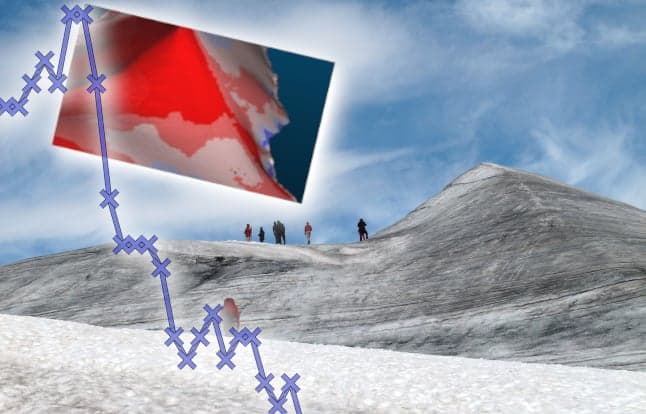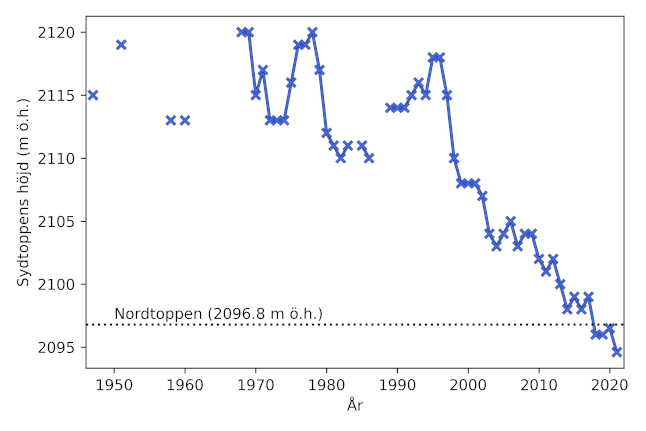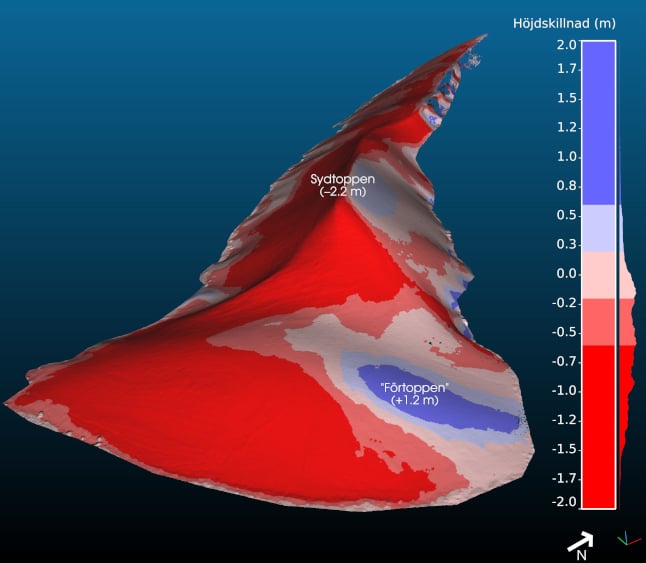IN PICTURES: Sweden's formerly tallest peak shrinks to new record levels

New images show the impact of climate change on Sweden's highest mountain, Kebnekaise.
Sweden’s tallest mountain Kebnekaise’s southern peak has shrunk by around two metres in the past year to 2,094.6 metres above sea level – the lowest it’s been since records began in the 1940s – according to new figures by Stockholm University's Tarfala research station.
Kebnekaise’s snow-covered southern peak was previously higher than the northern peak, but after battling global warming for years it melted below the other peak in 2018. The northern peak, which is not covered in snow, stands at 2,096.8 metres above sea level.
The snow on the southern peak has also grown in some places.
“The height variation is a good symbol of the glaciers’ response to a warming climate in Sweden. When hikers today climb the peak, they pass a flat part – a ‘pre-peak’ which did not exist in the early 2000s. Since 2020 the peak has become 2.2 metres lower, but the ‘pre-peak’ has grown by up to 1.2 metres,” glaciology professor Per Holmlund said in a statement released by the Tarfala research station on Tuesday.
Overall, the thickness of the snow cover on the southern peak has decreased by 0.5 metres since 2020. That corresponds to around 26,000 tonnes of water or 96 percent of the total volume of Kaknästornet, a 155 metre radio tower and landmark in Stockholm.
“The shrinking peak and the changed appearance of the snow drift can mainly be explained by rising air temperatures, but also changing wind conditions, which affect where the snow accumulates in winter,” read the Tarfala press release.

A graph that shows how the southern peak has shrunk in recent decades. Photo: Erik Schytt Mannerfelt/Tarfala Research Station
A key study released last week by the Intergovernmental Panel on Climate Change found that “the global nature of glacier retreat, with almost all of the world’s glaciers retreating synchronously, since the 1950s is unprecedented in at least the last 2000 years”, and predicted that glaciers will continue melting in centuries to come.
A less serious effect of Kebnekaise’s melting southern peak is that it makes climbing to Sweden's highest point significantly more challenging. Unlike its southern cousin which can be climbed by any reasonably fit person with sufficient equipment and planning, scaling the northern peak requires serious experience, a guide and proper climbing gear.

Red shows how the snow has decreased and blue shows an increase. Photo: Erik Schytt Mannerfelt/Tarfala Research Station
Comments
See Also
Sweden’s tallest mountain Kebnekaise’s southern peak has shrunk by around two metres in the past year to 2,094.6 metres above sea level – the lowest it’s been since records began in the 1940s – according to new figures by Stockholm University's Tarfala research station.
Kebnekaise’s snow-covered southern peak was previously higher than the northern peak, but after battling global warming for years it melted below the other peak in 2018. The northern peak, which is not covered in snow, stands at 2,096.8 metres above sea level.
The snow on the southern peak has also grown in some places.
“The height variation is a good symbol of the glaciers’ response to a warming climate in Sweden. When hikers today climb the peak, they pass a flat part – a ‘pre-peak’ which did not exist in the early 2000s. Since 2020 the peak has become 2.2 metres lower, but the ‘pre-peak’ has grown by up to 1.2 metres,” glaciology professor Per Holmlund said in a statement released by the Tarfala research station on Tuesday.
Overall, the thickness of the snow cover on the southern peak has decreased by 0.5 metres since 2020. That corresponds to around 26,000 tonnes of water or 96 percent of the total volume of Kaknästornet, a 155 metre radio tower and landmark in Stockholm.
“The shrinking peak and the changed appearance of the snow drift can mainly be explained by rising air temperatures, but also changing wind conditions, which affect where the snow accumulates in winter,” read the Tarfala press release.

A key study released last week by the Intergovernmental Panel on Climate Change found that “the global nature of glacier retreat, with almost all of the world’s glaciers retreating synchronously, since the 1950s is unprecedented in at least the last 2000 years”, and predicted that glaciers will continue melting in centuries to come.
A less serious effect of Kebnekaise’s melting southern peak is that it makes climbing to Sweden's highest point significantly more challenging. Unlike its southern cousin which can be climbed by any reasonably fit person with sufficient equipment and planning, scaling the northern peak requires serious experience, a guide and proper climbing gear.

Join the conversation in our comments section below. Share your own views and experience and if you have a question or suggestion for our journalists then email us at [email protected].
Please keep comments civil, constructive and on topic – and make sure to read our terms of use before getting involved.
Please log in here to leave a comment.